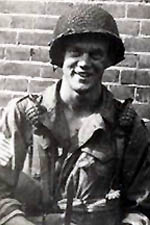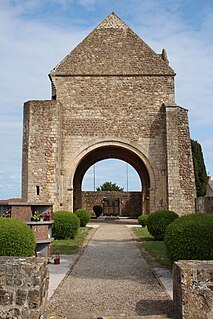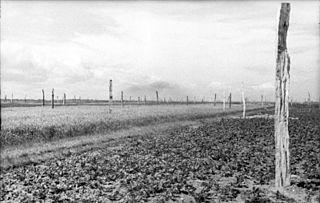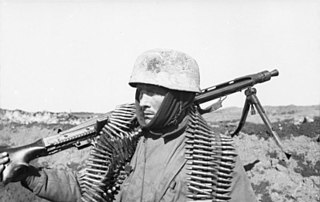
A paratrooper is a military parachutist—someone trained to parachute into a military operation, and usually functioning as part of an airborne force. Military parachutists (troops) and parachutes were first used on a large scale during World War II for troop distribution and transportation. Paratroopers are often used in surprise attacks, to seize strategic objectives such as airfields or bridges.

Airborne forces are ground combat units carried by aircraft and airdropped into battle zones, typically by parachute drop or air assault. Parachute-qualified infantry and support personnel serving in airborne units are also known as paratroopers.

The 82nd Airborne Division is an airborne infantry division of the United States Army specializing in parachute assault operations into denied areas with a U.S. Department of Defense requirement to "respond to crisis contingencies anywhere in the world within 18 hours". Based at Fort Bragg, North Carolina, the 82nd Airborne Division is part of the XVIII Airborne Corps. The 82nd Airborne Division is the U.S. Army's most strategically mobile division.

Sainte-Mère-Église is a commune in the northwestern French department of Manche, in Normandy. On 1 January 2016, the former communes of Beuzeville-au-Plain, Chef-du-Pont, Écoquenéauville and Foucarville were merged into Sainte-Mère-Église. On 1 January 2019, the former communes of Carquebut and Ravenoville were merged into Sainte-Mère-Église.

Operation Varsity was a successful airborne forces operation launched by Allied troops that took place toward the end of World War II. Involving more than 16,000 paratroopers and several thousand aircraft, it was the largest airborne operation in history to be conducted on a single day and in one location.

David Kenyon Webster was an American soldier, journalist and author. During World War II he was a private with E Company, 2nd Battalion, 506th Parachute Infantry Regiment, in the 101st Airborne Division. Webster was portrayed in the HBO miniseries Band of Brothers by Eion Bailey.

The 507th Parachute Infantry Regiment, now the 507th Infantry Regiment, is an airborne infantry regiment of the United States Army. The regiment was initially assigned to the 82nd Airborne Division in World War II before transferring to the 17th Airborne Division. Now 1st Battalion, 507th Infantry Regiment is part of the United States Army Infantry School, subordinate to its Airborne and Ranger Training Brigade, responsible for the Army's Basic Airborne School, Jumpmaster School, Pathfinder School, and the "Silver Wings" Command Exhibition Parachute Team.
Colonel Edson Duncan Raff was a United States Army officer and writer of a book on paratroopers. He served as Commanding Officer (CO) of the first American paratroop unit to jump into combat, the 2nd Battalion, 509th Parachute Infantry Regiment, near Oran as part of Operation Torch during World War II. His book, We Jumped to Fight, was based on his experience in that operation and was published in 1944.

The Filthy Thirteen was the name given to the 1st Demolition Section of the Regimental Headquarters Company of the 506th Parachute Infantry Regiment, 101st Airborne Division, of the United States Army, which fought in the European campaign in World War II. This unit was the inspiration for the 1965 book and 1967 film The Dirty Dozen.

The U.S. airborne landings in Normandy were the first U.S. combat operations during Operation Overlord, the invasion of Normandy by the Western Allies on June 6, 1944, during World War II. Around 13,100 American paratroopers of the 82nd and 101st Airborne Divisions made night parachute drops early on D-Day, June 6, followed by 3,937 glider troops flown in by day. As the opening maneuver of Operation Neptune the two American airborne divisions were delivered to the continent in two parachute and six glider missions.

The Battle of Graignes was part of the American airborne landings in Normandy during the early stages of Operation Overlord in World War II, fought between June 10–12, 1944 in Graignes, France. During the engagement, American paratroopers of the U.S. 82nd Airborne Division held the town for two days against the 17th SS Panzergrenadier Division Götz von Berlichingen. This action delayed the 17th SS Panzergrenadier's counterattack on Carentan, which was repulsed at the Battle of Bloody Gulch on June 13. After retaking Graignes, the German troops massacred 44 civilians and a number of prisoners of war taken in the capture of an American aid station, and set fire to the town.
Mission Boston was a parachute combat assault at night by Major General Matthew Ridgway's U.S. 82nd "All American" Airborne Division on June 6, 1944, part of the American airborne landings in Normandy during World War II. Boston was a component element of Operation Neptune, the assault portion of the Allied invasion of Normandy, codenamed Operation Overlord. 6,420 paratroopers jumped from nearly 370 C-47 Skytrain troop carrier aircraft into an intended objective area of roughly 10 square miles (26 km2) located on either side of the Merderet river on the Cotentin Peninsula of France, five hours ahead of the D-Day landings.
George Van Horn Moseley Jr. a United States Army officer who served in World War II, and later served as commandant of cadets at Norwich University.

The 3rd Battalion, Parachute Regiment, is a battalion sized formation of the British Army's Parachute Regiment and is a subordinate unit within 16 Air Assault Brigade.

Rommel's asparagus were 4-to-5-metre logs which the Axis placed in the fields and meadows of Normandy to cause damage to the expected invasion of Allied military gliders and paratroopers. Also known in German as Holzpfähle, the wooden defenders were placed in early 1944 in coastal areas of France and the Netherlands against airlanding infantry. Rommelspargel took their name from Field Marshal Erwin Rommel, who ordered their design and usage; Rommel himself called the defensive concept Luftlandehindernis.
Mark James Alexander was a United States Army officer and paratrooper during World War II.

The Fallschirmjäger were the paratrooper branch of the German Luftwaffe before and during World War II. They were the first German paratroopers to be committed in large-scale airborne operations. Throughout World War II, the commander of the branch was Kurt Student.
Yang Kyoungjong is the name of a Korean soldier who, according to some, fought in the Imperial Japanese Army, the Soviet Red Army, and later the German Wehrmacht during World War II. If he exists he is the only soldier in recent history thought to have fought on three sides of a war, and this status has earned him recognition.
Sidney Cornell was a British paratrooper serving during World War II.